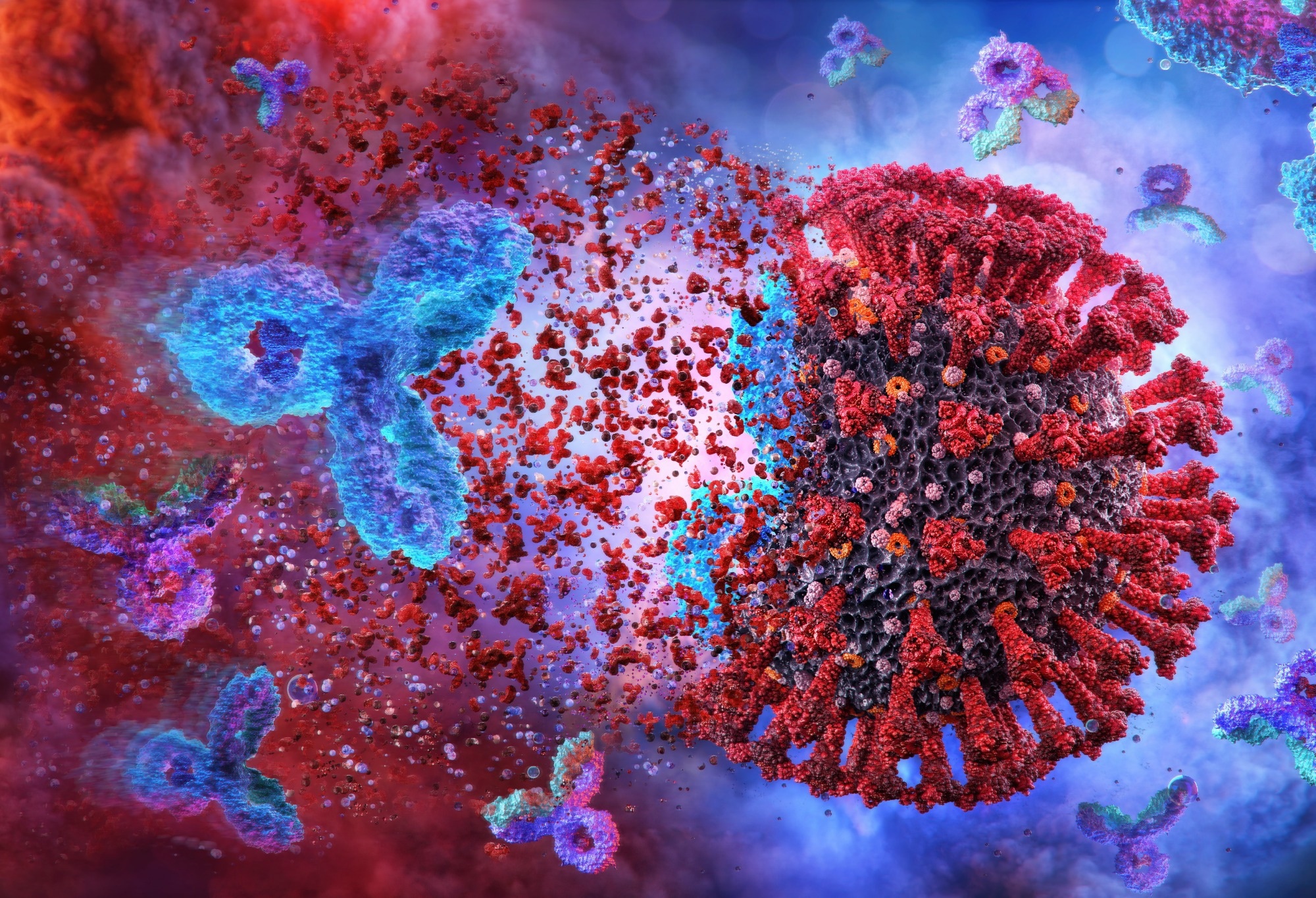In a recent article published in the Science Immunology Journal, researchers probed for antibody binding against all seven human coronaviruses (hCoVs) and 49 animal coronaviruses (aCoVs) represented as 12,924 peptides within a phage immunoprecipitation sequencing (PhIP) library.
The study used viruses harboring in multiple hosts, including bats, rodents, birds, raccoons, pangolins, etc., with the potential to spill over to humans.
 Study: Cross-reactive antibodies against human coronaviruses and the animal coronavirome suggest diagnostics for future zoonotic spillovers. Image Credit: CoronaBorealisStudio/Shutterstock.com
Study: Cross-reactive antibodies against human coronaviruses and the animal coronavirome suggest diagnostics for future zoonotic spillovers. Image Credit: CoronaBorealisStudio/Shutterstock.com
Background
Serological assays are based on antibody responses against pathogens, including highly pathogenic CoVs, e.g., SARS-CoV and Middle East Respiratory Syndrome (MERS)–CoV.
Thus, in contrast to nucleic acid–based testing, serological testing allows an assessment of the past exposure to a pathogen, thereby uncovering the contribution of asymptomatic cases.
This information is invaluable to understanding the population-wide exposure to a virus with pandemic potential. However, antibody cross-reactivity with similar antigens disturbs the accuracy of serological tests.
About the study
In the present study, researchers developed a synthetic oligo library where they presented peptide antigens from seven hCoVs and 49 aCoVs on pages (total of 12,924) and applied it to 269 serum samples from patients recovered from COVID-19 and 260 unexposed individuals to test immunoglobulin G (IgG) antibody binding against this CoV library. Specifically, 20% and 80% of peptides represented aCoV and CoV antigens.
Oligo lengths used in PhIP-Seq provide a unique layer of information unobtainable from working with full-length antigens or isolated domains. Given the high resolution of the peptide approach, we pinpoint the exact bound regions revealing crucial motifs responsible for cross-reactivities.
We have also demonstrated that PhIP-Seq can represent a powerful method to identify the targets of recombinant human mAbs, including cross-reactive recognition of similar peptides.
Additionally, they included severe acute respiratory syndrome coronavirus 2 (SARS-CoV-2) variants deposited in The National Center for Biotechnology Information (NCBI) database as of mid-April 2020.
After antigen-antibody interaction, they performed phage immunoprecipitation sequencing (PhIP) to ready the samples for deoxyribonucleic acid (DNA) sequencing and identify bound antigens in parallel. The team collected 260 pre-pandemic serum samples between 2013 and 2016. Likewise, they used COVID-19 convalescent antibody repertoires collected in April and May 2020 for comparative studies.
Results
The authors observed that antibody cross-reactivity triggered by SARS-CoV-2 infection and other hCoVs extended to aCoVs harboring inside diverse animals, i.e., their natural hosts, such as rodents, minks, porcine, birds, and bovine. Thus, PhIP-Seq seems like a great strategy to capture cross-reactive antibody responses at an epitopic resolution.
The study COVID-19 cohort had patients with mild symptoms who did not need hospitalization. However, if this cohort had patients with severe symptoms, the study used aCoV antigen library that could help compare antibody profiles of mild and severe COVID-19 patients against seasonal hCoVs. This information could inform us about the protective effects of cross-reactivity.
Many studies have shown that SARS-CoV elimination correlated with the antibody-dependent phagocytosis of alveolar macrophages, thus, suggesting that cross-reactive antibodies that do not target the receptor-binding domain (RBD) of CoVs might confer protection through non-neutralizing activity.
Conversely, preexisting cross-reactive antibodies could form immune complexes that could result in hyper-activation of the immune system. However, plasma transfer treatments of COVID-19 patients have shown that this phenomenon is insignificant for SARS-CoV-2.
The authors cloned two broadly reactive antibodies from rare memory cells carrying more somatic hypermutations (SHMs) than previously described neutralizing antibodies, raising the possibility that these monoclonal antibodies (mAbs) were preexistent (before exposure to SARS-CoV-2).
Due to their back-boosting, cross-reactive antibodies affected the severity of the disease. However, preexisting aCoV-specific memory cells with cross-reactive potential provided more protection against SARS-CoV-2 upon re-exposure. Nonetheless, these hypotheses require further investigation.
More SARS-CoV-2 infections and vaccinations could affect serological testing for future aCoV transmission events. However, on a positive note, if differences between a new CoV strain would be large enough to neutralize existing immunity and promote the spread of a new pandemic, it should also allow discrimination against existing CoVs with the proposed antigen library approach.
Intriguingly, antigens of aCoVs and all hCoVs (even after excluding SARS-CoV-2 antigens) allowed distinguishing COVID-19 convalescents from SARS-CoV-2-unexposed individuals with comparable precision as the complete antigen library, thus, enabling accurate diagnosis of the SARS-CoV-2 zoonosis.
The method used in this study showed the potential to distinguish SARS-CoV-2-exposed and unexposed individuals without using antigens of the causative CoV. In the future, it could help with serological assessment of future spillovers of aCoVs into humans.
However, it requires regularly updating antigen libraries representing genetic information of emerging aCoVs. A feasible strategy would require preparing such a library every year in autumn of the Northern Hemisphere to counter winters when transmission rates of potential new spillovers are the highest.
Most importantly, regularly updated aCoV libraries are highly accurate, have exceptional flexibility for robotic automation, and low cost to process phage-displayed libraries.
In the unfortunate event of the advent of a future virus with pandemic potential, researchers could omit the step of detecting and sequencing the new hCoV to generate antigens for enzyme-linked immunosorbent assay (ELISA) tests.
Instead, they could use large amounts of coronavirome phage libraries similar to the one used in this study and use them as a readily available tool in case serology testing is needed for a future spillover event. The authors also highlighted that continuous monitoring of the animal coronavirome as a CoV source is crucial.
Conclusions
Since single mAbs could mediate and extend human serum antibody cross-reactivity to aCoVs, a method using this pronounced cross-reactivity could have immense diagnostic applications.
Thus, they could serve as a great serological testing aid, especially during the early phases of future pandemics due to aCoVs spillover into humans.